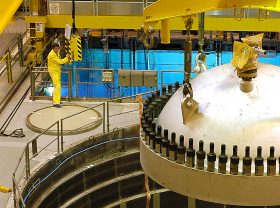Series of articles on barriers 4/6: The reactor pressure vessel (primary circuit part 1 of 2)
The reactor pressure vessel, together with the water’s cooling circuit, is the second barrier for trapping radioactive substances.
The primary circuit includes the reactor pressure vessel (RPV) and the cooling system. The RPV surrounds the reactor core, i.e. the fuel rod cladding tubes combined to form fuel assemblies filled with the fuel pellets.
Radiation is retained by the RPV wall

The RPV is a steel pressure vessel. Its extreme toughness makes the low-alloy fine-grained steel resistant to breaks and the propagation of cracks. In addition, the steel used is resistant to embrittlement under neutron irradiation. The thickness of the RPV’s wall can already screen part of the radiation.
Differences between boiling water and pressurised water reactors
In boiling water reactors, the RPV is exposed to lower temperatures and pressures than in pressurised water reactors.
At the Leibstadt nuclear power plant (Switzerland), with its boiling water reactor, the steel wall of the RPV is 15 centimetres thick. At 22 metres high and with a diameter of 6 metres, the RPV weighs about 600 tonnes. The RPV at the Gösgen nuclear power plant (Switzerland), with its pressurised water reactor, has a wall thickness of 22 centimetres with a diameter of over 4 metres and a height of 10 metres and weighs 360 tonnes.
Forged or rolled rings
An RPV consists of assembled steel rings or steel plates. These rings or plates are manufactured either by forging or rolling the steel. The Leibstadt nuclear power plant (Switzerland) has an RPV manufactured from rolled plates with longitudinal welds. The RPV at the Gösgen nuclear power plants in Beznau and Mühleberg consist of forged rings.
This is the fourth of six articles on the topic of barriers for trapping radioactive substances. The first describes the barrier principle, while articles 2 to 6 describe the various barriers.

